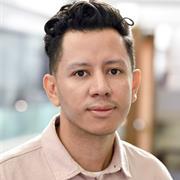Katerina Psarikidou and Alejandro Luna
Science Policy Research Unit, University of Sussex Business School

Katerina Psarikidou is Lecturer in Sustainable Development at the Science Policy Research Unit. She is the University of Sussex Business School PRME Champion, a UN initiative for Responsible Management Education. She is a Fellow of the Higher Education Academy and the Sussex Sustainability Research Programme. She is principal and co-investigator for 3 scholarship and research grants engaging in processes of co-creation with student and citizen communities. Her pedagogic scholarship is published at the international journals of ‘Postdigital Science and Education’ and ‘International Med Education’.

Alejandro Luna is a Lecturer in Sustainability, Innovation and Energy Policy in the Science Policy Research Unit (SPRU). He is convenor of the MSc course Science and Technology Policy. He is one of the Business School UN PRME Champion Institution Co-Leads. He is investigator in a USBS-funded scholarship grant. Alejandro sits at the Resilience Frontiers Technology Advisory Group (part of the UNFCCC secretariat). He is a Fellow of the Higher Education Academy.
Introduction
As part of our university lives, we have all encountered ideas of ‘inclusive curriculum design’ as a key objective and imperative of teaching and learning in Higher Education Institutions (HEIs). However, what does it mean? And, what is the role of students in it?
As early as 2011, Advance HE published its commissioned report ‘Inclusive Curriculum Design in Higher Education’ providing definitions, generic guidance as well as specific to subject or disciplinary area (Morgan and Houghton, 2011). According to this report, “an inclusive curriculum design approach is one that takes into account students’ educational, cultural and social background and experience as well as the presence of any physical or sensory impairment and their mental well-being” (Morgan and Houghton, 2011, p.5). As also highlighted in the report, “it is an imperative on institutions that they design their curriculum in such a way as to promote success among all students” (ibid:5).
From the above, we understand that students are central to the mission of (re)designing university curriculums in more inclusive ways. However, what needs to be clarified in the above, is the role that students can play in the process of (re)designing curriculums in more inclusive ways.
Inclusive curricula and co-creation
It is often the case that inclusive curriculums are designed by university educators themselves without engaging students in the formulation of ideas and proposals for more inclusive teaching, learning and assessment practices. As also discussed in relevant scholarship literature, student engagement can be key for student learning – not only in terms of securing the effectiveness of the (re)designed curricula, but also in terms of enhancing students’ belonging to the university, and therefore their overall levels of retention and academic performance (Zhao and Kuh, 2004; O’Keeffe, 2013).
This was also our experience and understanding from discussions we had with our students in late 2023, as part of our USBS-funded scholarship project titled ‘Co-creating a USBS staff-student community on innovative teaching and learning’.
In December of 2023, as part of our scholarship grant, we conducted two co-creation workshops with students from two ODL modules that each of us convened and had recently delivered. The ODL MSc Sustainable Development course provides fertile ground for (re)designing curricula in more inclusive ways – both in terms of the diversity of the student cohort coming from all parts of the world, age groups, ethnic, professional and disciplinary backgrounds, but also in terms of the challenges of inclusion that can sometimes emerge in relation to online teaching and learning (Mackenzie et al, 2021).
As also indicated in the title of our project, the aim of our workshops was to engage students in co-designing innovative methods for teaching, learning and assessments that would put students’ learning needs centre stage.
In both workshops, students highlighted inclusion as a key objective as well as a challenge for (re)designing the curriculum, especially in online environments. As said:
“I also just wanted to pick up on the interesting on the diversity and inclusion…that was what triggered my thinking around how I think it’s a real challenge when you’re doing online learning” (Student 1, Workshop 2, 2023)
Students as active agents in their own learning
As students explained, for them, ‘inclusion’ referred to a diversity of both teaching and learning methods that can cater to people’s different learning needs, but also to methods that can make students more active agents in their own learning.
For example, students from both workshops proposed student-led seminars for case-based learning. They proposed the organisation of cross-module seminars that would be led and delivered by students, in which students could present cases related to their own professional, cultural and disciplinary backgrounds and experiences.
As students explained, these seminars would also be important for enabling students to advance their knowledge by “putting theory into practice” (Student 1, Workshop 1, 2023). However, they also stressed the importance of these seminars in creating new more inclusive spaces of learning: both in terms of students being actively involved in running the seminars but also in terms of fostering social interaction and community belonging amongst themselves and to the university.
However, what students also underlined that they find “most useful” was “conversations like these” (Student 2, Workshop 1, 2023) facilitated by our workshops, and thus processes in which students feel included in discussions about (re)designing curriculum in more inclusive ways.
Thus, as evidenced in our workshops, questions and aspects of inclusion have been key in students’ discussions as well as their proposals going forward. Students talked about inclusion as a key challenge, especially in the context of online teaching and learning, but also as a key solution to enhancing their own student experience and learning. As also evidenced above, for them, (re)designing the curriculum in ways that would support the development of student-centred as well as student-led learning communities is key for supporting their learning in more inclusive ways. However, for students what is also important and would like to see more of is their engagement in processes of (re)designing the curriculum, in ways that have been done through our workshops!
Conclusion
The discussion above raises some broader questions about inclusive curriculum design. From our co-creation workshops, we learned that inclusive curriculum design is not just about methods of teaching in class and how to make them more inclusive. There is also a lot of learning that takes place outside the class, and it is for us, as educators, to support student learning by facilitating the development of those student-led communities of learning. Finally and very importantly, it is also very much about how to make processes of curriculum design more inclusive in order to design methods of teaching and learning that are truly inclusive. And, here student engagement is key. And, as students commented, our workshops can be an example of how this can be done!
References:
- MacKenzie A, Bacalja A, Annamali D, Panaretou A, Girme P, Cutajar M, Abegglen S, Evens M, Neuhaus F, Wilson K, Psarikidou K, Koole M, Hrastinski S, Sturm S, Adachi C, others (2022) Dissolving the dichotomies between online and campus-based teaching: A collective response to the manifesto for teaching online, Postdigital Science and Education, 4(2): 271-329.
- Morgan, H. and Houghton, A-M. (2011) Inclusive curriculum design in higher education: considerations for effective practices across and within subject areas, Advanced HE, available online at https://s3.eu-west-2.amazonaws.com/assets.creode.advancehe-document-manager/documents/hea/private/resources/introduction_and_overview_1568037036.pdf . Retrieved on 8 February 2024.
- O’Keefe, P. (2013). A Sense of Belonging: Improving Student Retention, College Student Journal, 47 (4): 605-613.
- Zhao, C.M. and Kuh, G.D. (2004). Adding Value: Learning Communities and Student Engagement. Research in Higher Education 45, 115–138.


[…] the ‘feedback gap’ for international postgraduate students: An embedded writing approach Student engagement is key for inclusive curriculum (re)design Developing a feedback policy for Life Science Strategies for making quantitative assessments […]